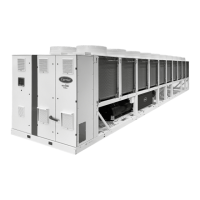OPERATING CHECKS:
■ Important : This product contains R1234ze(E) which is an
HFO gas.
■ Type of uid: Refer to the nameplate.
■ Global Warming Potential (GWP) following AR5 : 1.
WARNING:
1. Ensure that the refrigerant is never released to the
atmosphere during installation, maintenance or equipment
disposal.
2. Deliberate refrigerant release into the atmosphere is not
allowed.
3. If a refrigerant leak is detected, ensure that the leak is
repaired quickly.
4. Onlycertied,qualiedpersonnelarepermittedtoinstall,
service and perform leak tightness tests on the refrigerant,
decommission the equipment and recover the refrigerant.
5. The operator must ensure that any refrigerant recovered
is recycled, regenerated or destroyed.
6. The operator is bound by the obligation to perform leak
tightness tests, or have these performed, at regular
intervals. Regulations within the European Union have set
the following intervals:
System WITHOUT
leakage detection
No test 12 months 6 months 3 months
System WITH
leakage detection
No test 24 months 12 months 6 months
Refrigerant
charge per circuit
(equivalent CO
2
)
< 5 tons
5 ≤ charge
< 50 tons
50 ≤ charge
< 500 tons
Charge
> 500 tons*
Refrigerant
charge per
circuit (kg)
R-1234ze(E)
(GWP 1)
No requirement
* From 01/01/2017, units must be equipped with a leak detection system.
7. For all equipment subject to regular leak tightness tests,
the operator must keep a log used to record the following:
thequantitiesandtypesofuidscontainedinthesystem
(added and recovered), the quantity of uid recycled,
regenerated or destroyed, the date and results of the leak
tightness tests, the details of the technician and of the
company performing the work, etc.
8. Contact your local dealer or installer if you have any
questions.
Information on operating inspections given in EN 378 standard
can be used when similar criteria do not exist in the national
regulation.
Check regularly for leaks and repair immediately.
1.2.1 - Flammable refrigerant safety considerations
IMPORTANT INFORMATION REGARDING THE REFRIGERANT
USED:
R1234ze(E) refrigerant is classed in group 2 "non hazardous"
according to the criteria of the European pressure equipment
directives (PED) 2014/68/EC. In line with the standard ISO-819,
R1234ze(E) refrigerant is classed in safety group A2L: low
ammability.
One of the characteristics of this refrigerant is that no
flammable mixture is created with air below a room
temperature of 21 °C and under controlled humidity
conditions.
Nevertheless, when the humidity or temperature increases,
this refrigerant may become flammable and present a
potential hazard if the ammability risks are not correctly
mitigated within the installation's machine room.
The local safety regulations and standards relating to the
buildings must be respected.
In the absence of local regulations and standards, refer to
the standard EN-378 (2012) (Safety requirements for
substances classed A2) or ISO-5149 (2014) (for substances
classed A2L).
The customer must obtain the approval of the local authorities
governing the building. Carrier may also provide guidelines
on the safe use of refrigerant R1234ze(E), to complement the
safety standards and regulations relating to the buildings
with a view to ensuring risks are reduced to acceptable levels.
For more details on the physical properties, the ammability
and toxicity characteristics, the identication of risks, the
safety requirements for the installation, etc., refer to standards
such as the following:
■ ASHRAE 34, EN-378, ISO-817 and ISO-5149
■ Safety Data Sheets (SDS) provided by the refrigerant
manufacturer
■ The European Union REACH database (registration,
evaluation, authorisation and restriction of chemicals)
Only employ qualied technicians well-trained in the use and the
risks associated with ammable refrigerants and the respect of
local regulations (see standard EN 378-4 in appendix E - repair
guidelines for equipment using ammable refrigerants).
Use a gas detector during any intervention on the machine.
1 - SAFETY CONSIDERATONS
8

